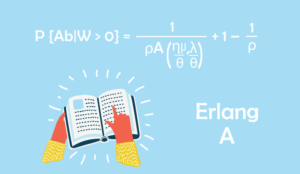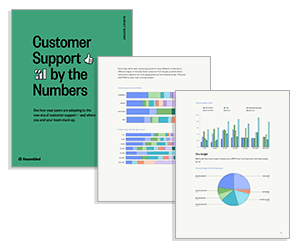Have you heard of Erlang X? No, it’s not a typo… Erlang X is a refreshing take on contact centre capacity calculations, picking up where Erlang C drops off!
Here, WFM expert Doug Casterton explains all – walking you through the details of Erlang X, breaking down its main formula, and discussing where it excels over Erlang C – alongside the best ways to apply Erlang X in your own forecasting and workforce management.
What Is Erlang X?
A Refreshing Take on Contact Centre Capacity Calculations
Erlang X is a refreshing take on contact centre capacity calculations. You might have heard about Erlang C, the tried-and-true formula created decades ago. Well, Erlang X begins where Erlang C drops off by handling customer abandonment and impatience more realistically.
For a quick explanation of the Erlang C Formula and how to use our free Erlang Calculator, watch the video below from Call Centre Helper’s Jonty Pearce:
Erlang X Calculates the Same Primary Inputs as Erlang C (Then It Adds Parameters)
At its core, Erlang X calculates the same primary inputs as Erlang C: forecasted call volume, average handling time (AHT), number of agents, and allowable wait time.
Then it adds parameters like average caller patience and even possible redials. It addresses scenarios where lines might be capped, so there’s a maximum queue size. (New calls are blocked once you exceed that size, or the system gives a busy tone, or sends the caller to voicemail.)
Modern contact centres have mostly moved beyond traditional line capacity constraints, particularly with cloud-based solutions and VoIP technology.
However, line capacity remains relevant in several contexts:
- Network bandwidth constraints
- Licensing costs per concurrent user
- System processing capacity
- Quality of service thresholds
Even with “unlimited” technical capacity, many centres deliberately implement artificial limits for a number of reasons, including:
- Cost control (pay-per-minute pricing models)
- Predictable performance planning
- Network resource optimization
Erlang X Calculates the Fraction of Abandoned Calls, Service Level, and More
One critical piece of data for Erlang X is the average patience level.
This number represents how long a typical caller will hang around on hold before abandoning the queue. Erlang X also calculates the fraction of abandoned calls, agent occupancy rates, average speed of answer, and service level. More advanced versions factor in the variance in call arrival and the probability that some portion of folks may redial.
This is a genuine attempt to reflect reality. We all know a few persistent personalities who keep trying until they reach a human voice. Hence, the formula can incorporate a “retrial rate”, adjusting how many calls pop back into your queue after an initial abandonment.
“The Restaurant Table Effect” Highlights How Erlang X Is Different From Erlang C
Erlang C was a miracle for its time, but it’s missing one vital ingredient: real-world customer behaviour. Folks eventually lose patience.
Some dangle on hold longer, others cut their losses quickly, and a fraction might keep calling back. Because Erlang C doesn’t deal with that complexity, it often tells you to staff for a scenario in which everyone waits forever or, at the very least, never leaves.
The “restaurant table effect” explains the difference best.
With Erlang C:
- You calculate you need 50 tables for 7 pm bookings
- 70 couples show up
- Everyone waits indefinitely for a table
Erlang X models the natural attrition:
- 10 couples leave when they see the line
- 5 more bail after checking wait times
- Staff adjusts table turnover based on real-time exits
That old approach costs contact centres money when staff rosters exceed actual needs. Agents might be half-bored, half-idle for big chunks of the day.
Meanwhile, there’s also the possibility that random fluctuations throw off your forecast. When that happens, the queue can feel chaotic, and your average speed of answer might shoot through the roof.
But if you plug those same data points into Erlang X, you get a more realistic measure that helps you see how many calls might slip away before hitting the queue or how many might dial back if they fail to connect.
In simpler terms, Erlang C is great when waiting is guaranteed. For instance, in a high-stakes government line or medical hotline, folks might hold as long as they must. But your customers might be less patient if you’re running a pizza place or an insurance claims centre.
Plus, if you’re dealing with a queue that has a finite capacity (maybe your phone system supports only a certain number of lines), Erlang X can give more accurate predictions. This helps your business ensure a stable and efficient operation without needing to pad your budget just in case.
When to Deploy Erlang X
“When a Chunk of Your Customers Are Dropping Off…”
Erlang X thrives when caller abandonment and queue limits are non-trivial factors.
Let’s say your average wait times tend to creep over 90 seconds. Even if those extra seconds sound harmless, you might be looking at a chunk of your customers dropping off. That’s a clear sign to explore a formula that actively accounts for caller patience.
For example, if you see regular spikes in call volume, maybe you release a monthly bill, or it’s open enrolment season in health insurance, and some fraction of your callers bail out faster than others.
“If You Need to See the Impact of Bottlenecks…”
Another scenario is when you want to model how your system behaves if lines are limited. If you’ve got 30 phone lines, for example, you can’t take the 31st call unless one of the others frees up. This artificially forces new arrivals away, so your forecast needs more sophistication.
Erlang X can tell you how that bottleneck might affect not just the calls that don’t get through initially but also your potential re-calls once folks see the line is busy.
“If You Want to Refine Your Approach to Agent Staffing and Scheduling…”
If you consider multichannel set-ups, you might still rely on the classic formula for quick phone queries while planning for a chat through a specialized chat concurrency model.
But the moment you suspect that your phone queue is losing folks because they won’t wait, it’s time to look at Erlang X. If you want to refine your approach to agent staffing and scheduling in a standard inbound service environment, you’ll likely see some immediate benefits.
The Do’s and Don’ts of Using Erlang X
Do: Analyse Data Carefully
Analyse your actual data carefully. Pull logs on how many people left the queue each day or hour, see how long they waited, and try to find an average patience number that matches your environment over a few months.
Do: Keep an Eye on Redials
Keep an eye on customer redials. If your data suggests that 20 percent of people who abandon promptly dial again, you’ll want to capture that in your formula.
If you are looking for advice on calculating your abandon rate, read our article: How to Measure Call Abandon Rate
Don’t: Rely on a Single Data Point
Don’t rely on a single data point for an entire workforce plan. Some folks love to grab an average from last month and run with it.
That might look tidy in a spreadsheet, but you’ll be over in some intervals and under in others. Instead, break it down by hour or half-hour across peak seasons.
Do: Let Erlang X Do the Heavy Lifting
Then, let Erlang X do the heavy lifting for each period. It’s always better to staff with an understanding of the daily ebb and flow of calls.
Summarizing every day or even every week into one line item removes the nuance, which is precisely where your most significant wins in planning come from.
Don’t: Underestimate the Caller’s Patience
One mistake is underestimating the caller’s patience. If you only track how long abandoned callers lasted on hold, you’ll miss all the patient folks who made it through. So, it’s easy to report a smaller average patience level than is true overall.
However, that can lead you to staff up too aggressively because your system will think more people leave early. Then your occupancy might drop, and you’ll be spending money you could have used elsewhere.
For advice on how to measure and calculate occupancy, read our article: How to Calculate Occupancy in the Contact Centre
Don’t: Guess a Random Patience Metric
Another mistake is guessing a random patience metric. If you only skim the data, you might assign an average of 90 seconds for everyone.
But your actual distribution might be pretty different, with half the callers dropping at 30 seconds, others at 45 seconds, and a smaller fraction at 2 minutes. A naive approach skews your entire model!
Do: Keep Your Line Parameters Well Above Your Expected Arrival Rate
Lastly, keeping your line parameters well above your expected arrival rate is also prudent. If it’s too short, the formula might overcompensate by telling you that fewer calls even have a chance to queue, artificially lowering your staffing needs.
In practice, you don’t want customers hitting a busy signal if you can avoid it. Setting the lines parameter to match your highest forecasted call volume, or a bit beyond that, stabilizes your results.
Common Misconceptions About Erlang X
“It Always Calls for Fewer Agents Than Erlang C…”
One common misconception is that Erlang X always calls for fewer agents than Erlang C. That’s often true if your customers are known to be impatient, but not guaranteed in every scenario.
Sometimes, your queue lengths are minimal, or your brand fosters loyal audiences who rarely abandon the line. The difference between Erlang X and Erlang C might be negligible in such cases.
The key is measuring dissatisfaction or impatience among your callers to see if it’s an actual problem. If only 2 percent of customers drop off, Erlang X might not adjust its staffing requirements much.
“It Is Too Complicated to Figure Out…”
Another misconception is that Erlang X is too complicated to figure out. Sure, it has more parameters than Erlang C, and you need to track data like average patience or redial rates.
Yet once someone shows you the formula or uses a software tool that supports Erlang X, you’ll see that the concept remains straightforward.
You just have to feed in the normal data calls per hour, handle time and target wait, and then add more detail on how your callers behave when they’re tired of holding.
A Quick Look at Erlang X and Its History
The Need to Consider Individual Behaviours Gave Rise to Erlang X
Erlang C has been the staple of contact centre forecasting and capacity planning for over a century, dating back to A. K. Erlang’s time in 1917 when he worked on telephone traffic theory.
He realized that random call arrivals could be captured with Poisson distributions, letting analysts predict call loads and how many staff members might be needed.
Interestingly, Erlang first developed the Erlang B (B for Blocking) algorithm. Not surprisingly, however, because the challenges of telephone traffic theory back then focused on how many concurrent lines would be needed as a customer would be blocked from using beyond this capacity.
Since then, the contact centre landscape has rapidly evolved. Customers are no longer just patient souls. Some will bail out as soon as they sense a looming queue.
Others may hang on longer, while a fraction might quickly dial again if they didn’t get through. This need to consider individual behaviours gave rise to Erlang X.
Conny Palm Was the First to Incorporate Abandonments Into Queuing Systems
In the 1960s, Swedish mathematician Conny Palm was the first to incorporate abandonments into queuing systems. While Erlang himself did not account for abandonments in his original queuing models, Palm’s work evolved into what we now know as the Erlang A formula.
It alters Erlang C’s original premise, which assumes that everyone waits as long as it takes. Erlang A embraces reality by saying, “Sure, some people will wait, but others will vanish after 30 seconds, maybe 60 seconds, or occasionally even 5 minutes.”
The key addition Palm made was recognizing that:
- Customer abandonment makes any call centre inherently stable
- Service levels never truly reach 0% due to abandonment effects
- Queue length and waiting times are impacted by customers leaving the queue
This innovation was significant because it made the mathematical models much more realistic compared to Erlang C’s assumption of infinite customer patience. However, it’s worth noting that accurately determining average customer patience (a key input for Erlang X) remains a complex statistical challenge.
We can only measure the patience of customers who actually abandon the queue, potentially underestimating the patience of customers who stay in the queue.
Ger Koole Combined Three Essential Properties to Bring Us the Erlang X Model
The next evaluation took place in the 1990s, when Ger Koole, a Dutch mathematician, combined three essential properties:
- The abandonments derived from the Erlang A model
- The blocking parameter from the Erlang B model
- The retrial property
- When a customer hangs up, the customer is likely to call again, and this retrial property dramatically influences the number of agents needed, just like the abandonments do.
And combining these three properties into 1 calculation brought us the Erlang X model!
No Formula Is a One-Size-Fits-All Solution

Erlang X represents a modern evolution of Erlang’s century-old maths, fine-tuned for the contact centres we know today. It tackles the reality that callers are human. They get tired, frustrated, or busy, so they hang up or sometimes dial right back.
This formula lets you staff confidently, avoiding the risk of overspending on a large team you don’t need. It also helps reduce long queues, ensuring customers willing to hold aren’t forced to wait too long.
Remember, no formula is a one-size-fits-all solution. Erlang C still has its place for scenarios with minimal drop-offs, while Erlang X shines in those creative real-world situations in which lines or patience run short. Understanding which approach suits you best is the key to a calmer, happier team and a better-organized customer experience.
So, whether you’re a veteran of contact centre staffing or a newbie just diving into the subject, I hope you have a more straightforward understanding of how Erlang X might help.
It’s not about memorizing equations. It’s about choosing realistic models that fit your current environment, data accuracy, and the service levels you aim to achieve.
Getting Started With Erlang X
Ready to dive into Erlang X? Let me point you toward some practical resources. A free online calculator awaits at the CCmaths website, perfect for experimenting with different scenarios and seeing the magic happen in real time.
For those who prefer getting their hands dirty with code, grab the Excel VBA version, or if Python or R speaks your language, those flavours exist too.
CCmaths also offers on their website an Erlang X Savings Calculator that demonstrates how this modern approach outperforms traditional Erlang C. Watch your potential savings stack up as the calculator factors in those pesky abandonments and persistent redials. Trust me, nothing speaks louder than seeing the numbers dance.
Written by: Doug Casterton, All things Workforce Management (WFM) and weWFM Podcast Host
If you are looking for more information on Erlang calculations, read these articles next:
- Erlang Calculation – An Introduction
- A Beginner’s Guide to the Erlang A Formula
- Erlang C Formula – Made Simple With an Easy Worked Example
Author: Doug Casterton
Reviewed by: Xander Freeman
Published On: 25th Mar 2025 - Last modified: 2nd Apr 2025
Read more about - Workforce Planning, Capacity, Doug Casterton, Editor's Picks, Erlang Calculations, Forecasting, Top Story, Workforce Management (WFM)

















